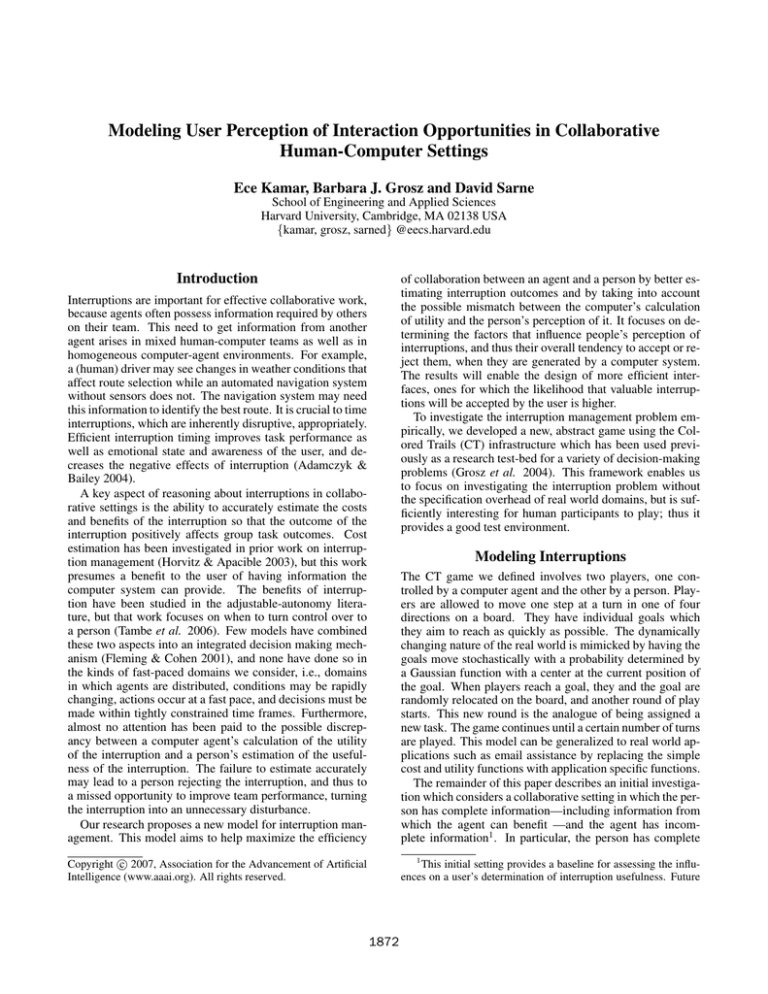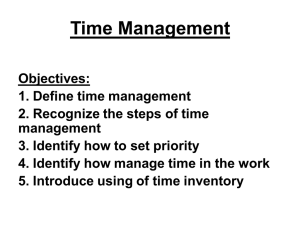Modeling User Perception of Interaction Opportunities in Collaborative Human-Computer Settings Introduction
advertisement

Modeling User Perception of Interaction Opportunities in Collaborative
Human-Computer Settings
Ece Kamar, Barbara J. Grosz and David Sarne
School of Engineering and Applied Sciences
Harvard University, Cambridge, MA 02138 USA
{kamar, grosz, sarned} @eecs.harvard.edu
Introduction
of collaboration between an agent and a person by better estimating interruption outcomes and by taking into account
the possible mismatch between the computer’s calculation
of utility and the person’s perception of it. It focuses on determining the factors that influence people’s perception of
interruptions, and thus their overall tendency to accept or reject them, when they are generated by a computer system.
The results will enable the design of more efficient interfaces, ones for which the likelihood that valuable interruptions will be accepted by the user is higher.
To investigate the interruption management problem empirically, we developed a new, abstract game using the Colored Trails (CT) infrastructure which has been used previously as a research test-bed for a variety of decision-making
problems (Grosz et al. 2004). This framework enables us
to focus on investigating the interruption problem without
the specification overhead of real world domains, but is sufficiently interesting for human participants to play; thus it
provides a good test environment.
Interruptions are important for effective collaborative work,
because agents often possess information required by others
on their team. This need to get information from another
agent arises in mixed human-computer teams as well as in
homogeneous computer-agent environments. For example,
a (human) driver may see changes in weather conditions that
affect route selection while an automated navigation system
without sensors does not. The navigation system may need
this information to identify the best route. It is crucial to time
interruptions, which are inherently disruptive, appropriately.
Efficient interruption timing improves task performance as
well as emotional state and awareness of the user, and decreases the negative effects of interruption (Adamczyk &
Bailey 2004).
A key aspect of reasoning about interruptions in collaborative settings is the ability to accurately estimate the costs
and benefits of the interruption so that the outcome of the
interruption positively affects group task outcomes. Cost
estimation has been investigated in prior work on interruption management (Horvitz & Apacible 2003), but this work
presumes a benefit to the user of having information the
computer system can provide. The benefits of interruption have been studied in the adjustable-autonomy literature, but that work focuses on when to turn control over to
a person (Tambe et al. 2006). Few models have combined
these two aspects into an integrated decision making mechanism (Fleming & Cohen 2001), and none have done so in
the kinds of fast-paced domains we consider, i.e., domains
in which agents are distributed, conditions may be rapidly
changing, actions occur at a fast pace, and decisions must be
made within tightly constrained time frames. Furthermore,
almost no attention has been paid to the possible discrepancy between a computer agent’s calculation of the utility
of the interruption and a person’s estimation of the usefulness of the interruption. The failure to estimate accurately
may lead to a person rejecting the interruption, and thus to
a missed opportunity to improve team performance, turning
the interruption into an unnecessary disturbance.
Our research proposes a new model for interruption management. This model aims to help maximize the efficiency
Modeling Interruptions
The CT game we defined involves two players, one controlled by a computer agent and the other by a person. Players are allowed to move one step at a turn in one of four
directions on a board. They have individual goals which
they aim to reach as quickly as possible. The dynamically
changing nature of the real world is mimicked by having the
goals move stochastically with a probability determined by
a Gaussian function with a center at the current position of
the goal. When players reach a goal, they and the goal are
randomly relocated on the board, and another round of play
starts. This new round is the analogue of being assigned a
new task. The game continues until a certain number of turns
are played. This model can be generalized to real world applications such as email assistance by replacing the simple
cost and utility functions with application specific functions.
The remainder of this paper describes an initial investigation which considers a collaborative setting in which the person has complete information—including information from
which the agent can benefit —and the agent has incomplete information1 . In particular, the person has complete
c 2007, Association for the Advancement of Artificial
Copyright Intelligence (www.aaai.org). All rights reserved.
1
This initial setting provides a baseline for assessing the influences on a user’s determination of interruption usefulness. Future
1872
belief state b, which is a probability distribution over the possible goal positions; and current turn h. After each turn, b is
updated to b with State Estimator (SE).
b (c ∈ B) = SE(c ) = c∈B b(c) × M P (c , p, c)
EUAN I = EUA (p, b, h) and EUAI = EUA (p, b , h + 1)
information about both players and their goals, whereas the
agent lacks current information about its goal’s position (but
knows its position, the position of the person and the person’s goal). The agent must initiate interactions with the
user to learn its actual goal position. We model the cost
of interruption as the loss of the opportunity to move for
one turn. At the beginning of each turn, the agent decides
whether to interrupt the user or not. The person is free to accept or reject an interruption request. If the person responds
positively to an interruption request, the agent is told the current position of its goal and both players are prohibited from
moving for this turn.
The players share a common scoring function S,
S = SP + SA and Si = k (s − hk )
Experimental Setting
We are currently running experiments of participants playing this CT game in a lab setting. To evaluate the agent’s interruption decision making performance, we simulate three
homogeneous agent settings and compare the outcomes with
the results of the human-agent experiments. The agent settings comprise two computer agents with different capabilities: (1) both agents have complete information; (2) one
agent has incomplete information, but is able to interrupt the
other agent; and (3) one agent has incomplete information
and is not able to interrupt the other.
A second set of computer-human experiments uses handcrafted interruptions generated by the computer agent,
which vary such parameters as the complexity of calculating
costs and gains, the magnitude of the EOI, and the type of
the collaborator. The experiments aim to identify the subset
of factors an agent needs to focus on for learning or profiling
to better predict a user’s tendency to accept interruptions.
where SA and SP denote the agent’s and the person’s accumulated (individual) points, respectively, s is the number of
points given for reaching a goal, hk is the number of moves
it takes for the player to get to the kth goal, and the sum is
over all goals that have been reached by player i. The objective of players is to maximize S. The person has an incentive
to accept interruption requests, because overall success depends on the agent’s ability to reach its goal.
The expected outcome of interruption (EOI) is the difference between the expected outcome (EO) of the game when
there is an interruption and the EO when no such interruption takes place. The agent interrupts the user when the EOI
is estimated to be positive. This calculation requires deriving joint policies for the collaborative group of agent and
user, a problem which may be modeled as a Decentralized
POMDP (Dec-POMDP). However, the complexity of the solution is NEXP-complete. 2 As a result, our approach is to
estimate the EOI by combining agent and person-sided estimates of interruption outcomes using the equations below,
where I indicates Interruption, N I indicates No Interruption, and EU indicates Expected Utility:
Conclusion and Future Work
This paper describes an experimental design and a computational framework for exploring an integrated interruption
model in collaborative settings to determine how people perceive the effectiveness of interruption.
References
Adamczyk, P., and Bailey, B. 2004. If not now, when?:
the effects of interruption at different moments within task
execution. In CHI ’04, 271–278.
Fleming, M., and Cohen, R. 2001. A user modeling approach to determining system initiative in mixed-initiative
ai systems. In UM ’01, 54–63.
Grosz, B.; Kraus, S.; Talman, S.; Stossel, B.; and Havlin,
M. 2004. The influence of social dependencies on decisionmaking: Initial investigations with a new game. AAMAS’04
02:782–789.
Horvitz, E., and Apacible, J. 2003. Learning and reasoning
about interruption. In ICMI ’03, 20–27.
Kamar, E., and Grosz, B. J. 2007. Applying MDP approaches for estimating outcome of interaction in collaborative human-computer settings. In MSDM 2007, 25–32.
Tambe, M.; Bowring, E.; Pearce, J.; Varakantham, P.;
Scerri, P.; and Pynadath, F. 2006. Electric elves: What
went wrong and why. In AAAI’06.
EOI = EOIP + EOIA
EOIP =EUPI – EUPN I and EOIA = EUAI –EUAN I
The person-side estimate may be modeled by a Markov Decision Process (MDP), because the person is able to observe
the complete state of the world. ExpectiMax is used to calculate EUP for the current state of the world, which is represented by person-player position p, goal position g and
current turn h. Given that B indicates the set of possible
board positions and M P (g , p, g) is the probability of a goal
move from position g to g with player position p,
EUPI =
EUPN I = EUP (p, g, h)
g ∈B M P (g , p, g) × EUP (p, g , h + 1).
The modeling of the agent-side requires a Partially Observable MDP (POMDP), because the agent does not have complete information about the state of the world. The current
state of the game is represented by agent-player position p;
The research reported in this paper was supported in part by
NSF grants IIS-0222892 and CNS-0453923 and in part by contract
number 55-000720, a subcontract to SRI International’s DARPA
Contract No. FA8750-05-C-0033. Any opinions, findings and conclusions, or recommendations expressed in this material are those
of the authors and do not necessarily reflect the views of NSF,
DARPA or the U.S. Government.
work will vary the allocation of information.
2
Comprehensive analyses of the problem, MDP, POMDP and
Dec-MDP approaches may be found in a longer paper (Kamar &
Grosz 2007).
1873



